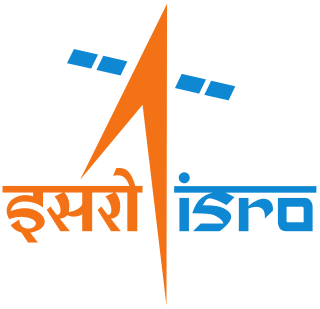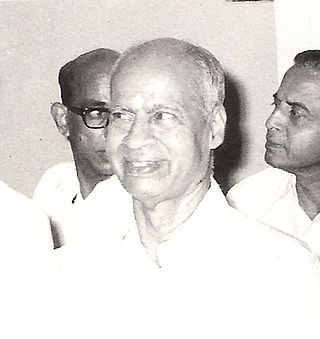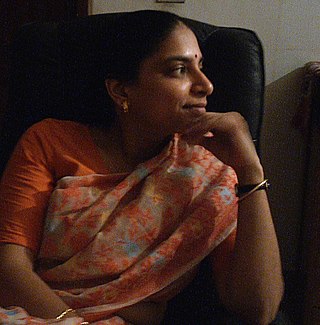
The Indian Space Research Organisation is the national space agency of India. It operates as the primary research and development arm of the Department of Space (DoS), which is directly overseen by the Prime Minister of India while the Chairman of ISRO also acts as the executive of DoS. ISRO is primarily responsible for performing tasks related to space-based operations, space exploration, international space cooperation and the development of related technologies. ISRO is one of the six government space agencies in the world that possesses full launch capabilities, can deploy cryogenic engines, can launch extraterrestrial missions and operate a large fleet of artificial satellites. ISRO is one of the four government space agencies to have soft landing (uncrewed) capabilities.

Chandrayaan-1 was the first Indian lunar probe under the Chandrayaan programme. It was launched by the Indian Space Research Organisation (ISRO) in October 2008, and operated until August 2009. The mission included an orbiter and an impactor. India launched the spacecraft using a PSLV-XL rocket on 22 October 2008 at 00:52 UTC from Satish Dhawan Space Centre, at Sriharikota, Andhra Pradesh. The mission was a major boost to India's space program, as India researched and developed indigenous technology to explore the Moon. The vehicle was inserted into lunar orbit on 8 November 2008.

Vikram Ambalal Sarabhai Jain was an Indian physicist and astronomer who initiated space research and helped to develop nuclear power in India.

Mylswamy Annadurai, popularly known as Moon Man of India, is an Indian scientist working as vice president for Tamil Nadu State Council for Science and Technology (TNSCST), Chairman, Board of Governors, National Design and Research Forum(NDRF. He was born on 2 July 1958, in a village called Kothavadi near Pollachi in Coimbatore district, Tamil Nadu state of India). Prior to taking this assignment he was with Indian Space Research Organisation and served as Director, ISRO Satellite Centre (ISAC), Bangalore. During his 36 years of service in ISRO, he had some of the major contributions, including two of the major missions of ISRO, namely Chandrayaan-1 and Mangalyaan. Annadurai has been listed among 100 Global thinkers of 2014 and topped the innovators list. His works are mentioned in textbooks of Tamil Nadu Board of Secondary Education

Pisharoth Rama Pisharoty was an Indian physicist and meteorologist, and is considered to be the father of remote sensing in India.

G. Madhavan Nair is an Indian space scientist and a former Chairman of the Indian Space Research Organisation, and Secretary to the Department of Space, Government of India. He has also been the Chairman of the Space Commission and Chairman of the Governing Body of the Antrix Corporation, Bangalore.

Chandrayaan-2, is the second lunar exploration mission developed by the Indian Space Research Organisation (ISRO), after Chandrayaan-1. It consists of a lunar orbiter, and formerly included the Vikram lander and the Pragyan rover, all of which were developed in India. The main scientific objective is to map and study the variations in lunar surface composition, as well as the location and abundance of lunar water.

Koppillil Radhakrishnan is an Indian space scientist who headed the Indian Space Research Organisation (ISRO) between November 2009 and December 2014 as Chairman of Space Commission, Secretary of the Department of Space and Chairman of ISRO. Prior to this, he was the Director of Vikram Sarabhai Space Centre (2007-2009) and Director of National Remote Sensing Agency (2005-2008) of the Department of Space. He had a brief stint of five years (2000-2005) in the Ministry of Earth Sciences as Director of Indian National Centre for Ocean Information Services (INCOIS). Under his leadership of ISRO, India became the first country to reach Mars in its first attempt.
Thekkethil Kochandy Alex is an Indian space scientist. He was the director of the ISRO Satellite Centre (ISAC) of Indian Space Research Organisation (ISRO) (2008–2012) and Member, Space Commission. He specialized in electro-optic systems and satellite technology. Starting with the first Indian satellite Aryabhata, he has been responsible for the sensor systems in all the Indian satellites. Under his leadership the Laboratory for Electro Optics Systems (LEOS) was established in 1993 and from the inception he was its director till 2008. He was conferred "Dr. Vikram Sarabhai Distinguished Professorship" in 2011.

Charusita Chakravarty was an Indian academic and scientist. She was a professor of chemistry at the Indian Institute of Technology, Delhi since 1999. In 2009 she was conferred Shanti Swarup Bhatnagar Prize for Science and Technology in the field of chemical science. In 1999, she received B.M. Birla Science Award. She was an Associate Member of the Centre for Computational Material Science, Jawaharlal Nehru Centre for Advanced Scientific Research, Bangalore.

Anil Kumar Tyagi is former Vice Chancellor of Guru Gobind Singh Indraprastha University Delhi. Prior to this he was co-ordinator of UGC- SAP Programme and head of Department of Biochemistry at South Campus of Delhi University and was Vice President of the Society of Biological Chemists, India from the year 2004 to 2006.

Sachchida Nand Tripathi is an Indian scientist who works in the field of Atmospheric Sciences. He is a Higher Administrative Grade Professor in the Department of Civil Engineering and also joint faculty at the Department of Sustainable Energy Engineering at Indian Institute of Technology, Kanpur. He currently holds the Arjun Dev Joneja Faculty Chair in the department. Prof. Tripathi is recipient of Infosys Prize 2023. Council for Scientific and Industrial Research Government of India awarded him with Shanti Swarup Bhatnagar Award for Science and Technology, the highest science award in India, for his outstanding contribution in the field of Earth, Atmosphere, Ocean and Planetary sciences in 2014. Prof. Tripathi is an elected Fellow of major Sciences and Engineering academies of the country: Indian National Science Academy, National Academy of Sciences, Indian National Academy of Engineering and also holds J. C. Bose Fellowship of Department of Science and Technology (India). He was awarded the Infosys Prize 2023 in Engineering and Computer Science for the deployment of large-scale sensor-based air quality network and mobile laboratory for hyper local measurements of pollution, data generation and analysis using AI+ML for effective air quality management and citizen awareness, and for the discovery of new pathways of aerosols formation and growth that provide mechanistic understanding of haze formation.

Prem Shanker Goel is an Indian space scientist, former secretary at the Department of Ocean Development, Ministry of Earth Sciences, Government of India and a former director of Indian Space Research Organization. He was honored by the Government of India, in 2001, with the fourth highest Indian civilian award of Padma Shri.
Mars Orbiter Mission 2, is a proposed second mission to Mars by the Indian Space Research Organisation (ISRO). In a recorded interview in October 2019, the Vikram Sarabhai Space Centre (VSSC) director indicated the possibility of inclusion of a lander, but in an interview to The Times Of India in February 2021 the ISRO chairman clarified that the mission will consist solely of an orbiter. The orbiter will use aerobraking to lower its initial apoapsis and enter into an orbit more suitable for observations.
Onkar Nath Srivastava was an Indian material physicist, an Emeritus professor of Banaras Hindu University and the vice president for India and South Asia of the International Association for Hydrogen Energy, who was known for his contributions to the disciplines of nanotechnology and hydrogen energy. He was the author of two books and over 440 scientific papers and a recipient of several honors including Shanti Swarup Bhatnagar Prize, the highest Indian award in the science and technology categories. The Government of India awarded him the fourth highest civilian honour of the Padma Shri, in 2016, for his contributions to science and engineering.

Jitendranath Goswami is an Indian scientist from Jorhat, Assam. He was the Chief Scientist of Chandrayaan-1, and was also the developer of this project. He served as a director of Physical Research Laboratory situated at Ahmadabad, Gujarat. He was also associated with Chandrayaan-2 and Mangalyaan.

Rengaswamy Ramesh (1956–2018) was an Indian climatologist, oceanographer, a former Prof. Satish Dhawan Professor at the Physical Research Laboratory and a senior professor at the National Institute of Science Education and Research, Bhubaneswar. He was known for paleo-climatic and paleo-oceanographic studies and was an elected fellow of all the three major Indian science academies viz. Indian National Science Academy, Indian Academy of Sciences, and the National Academy of Sciences, India as well as of The World Academy of Sciences. The Council of Scientific and Industrial Research, the apex agency of the Government of India for scientific research, awarded him the Shanti Swarup Bhatnagar Prize for Science and Technology, one of the highest Indian science awards for his contributions to Earth, Atmosphere, Ocean and Planetary Sciences in 1998.
Sreedharan Krishnakumari Satheesh is an Indian meteorologist and a professor at the Centre for Atmospheric and Oceanic Sciences of the Indian Institute of Science (IISc). He holds the chair of the Divecha Centre for Climate Change, a centre under the umbrella of the IISc for researches on climate variability, climate change and their impact on the environment. He is known for his studies on atmospheric aerosols and is an elected fellow of all the three major Indian science academies viz. Indian Academy of Sciences Indian National Science Academy and the National Academy of Sciences, India as well as The World Academy of Sciences. The Council of Scientific and Industrial Research, the apex agency of the Government of India for scientific research, awarded him the Shanti Swarup Bhatnagar Prize for Science and Technology, one of the highest Indian science awards for his contributions to Earth, Atmosphere, Ocean and Planetary Sciences in 2009. He received the TWAS Prize of The World Academy of Sciences in 2011. In 2018, he received the Infosys Prize, one of the highest monetary awards in India that recognize excellence in science and research, for his work in the field of climate change.

Pragyan is a lunar rover that forms part of Chandrayaan-3, a lunar mission developed by the Indian Space Research Organisation (ISRO). A previous iteration of the rover was launched as part of Chandrayaan-2 on 22 July 2019 and was destroyed with its lander, Vikram, when it crashed on the Moon on 6 September. Chandrayaan-3 launched on 14 July 2023, carrying new versions of Vikram and Pragyan, which successfully landed near the lunar south pole on 23 August 2023.
The Lunar Polar Exploration Mission (LUPEX) is a planned joint lunar mission by the Indian Space Research Organisation (ISRO) and Japan Aerospace Exploration Agency (JAXA). The mission would send an uncrewed lunar lander and rover to explore the south pole region of the Moon no earlier than 2026.It is envisaged to explore the permanently shadowed regions on the Moon. JAXA is likely to provide the H3 launch vehicle and the rover, while ISRO would be providing the lander.














